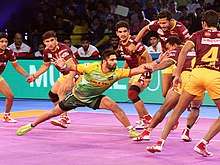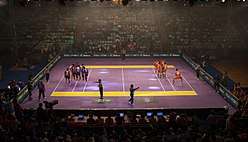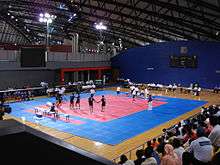Kabaddi
 Kabaddi game | |
| Highest governing body | International Kabaddi Federation |
|---|---|
| Nicknames | Kaudi, Pakaada, Hadudu, Bhavatik, Saadukuda, Hu-Tu-Tu, Himoshika, sadugudu |
| Clubs | Bengal Warriors,Puneri Paltan,Telegu Titans;Bengaluru Bulls,Dabang Delhi,Jaipur Pink Panthers,Patna Pirates,U MUmba,Haryana Steelers,UP Yoddha,Tamil Thalaivas,Gujrat Fortune Giants |
| Characteristics | |
| Contact | Permitted |
| Team members | 7 (per side) |
| Mixed gender | Yes, separate competitions |
| Type | Team sport, Contact sport |
| Equipment | None |
| Venue | Kabaddi court |
| Presence | |
| Country or region | Indian Subcontinent |
| Olympic | Demonstration sport : 1936 Olympics |
Kabaddi is a contact team sport originating from ancient India.[1] The game is said to have had its inception in Ancient India where it was played all over in different forms.[2] It became popular in Punjab as it was part of their martial traditions.[3] It is popular in the Indian subcontinent and is the state game of the Indian states of Andhra Pradesh, Uttar Pradesh, Karnataka, Kerala, Bihar, Haryana, Maharashtra, Punjab, Telangana, Tamil Nadu[4] and is the national sport of Bangladesh[5] and was of Nepal until 2017.
Kabaddi is played between two teams of seven players. The objective of the game is for a single player on offence, referred to as a "raider", to run into the opposing team's half of a court, tag out as many of their defenders as possible, and return to their own half of the court, all without being tackled by the defenders. Points are scored for each player tagged by the raider, while the opposing team earns a point for stopping the raider. Players are taken out of the game if they are tagged or tackled, but can be "revived" for each point scored by their team from a tag or tackle.
The game is known by its regional names in different parts of the Indian subcontinent, such as, kabaddi or chedugudu in Andhra Pradesh, kabaddi in Karnataka, Kerala and Telangana, hadudu in Bangladesh, bhavatik in Maldives, kauddi or kabaddi in the Punjab region, hu-tu-tu in Western India, hu-do-do in Eastern India, chadakudu in South India, kapardi in Nepal and kabaddi or sadugudu in Tamil Nadu.
History
Kabaddi originated in ancient India.[6] Kabaddi received international exposure at the 1936 Berlin Olympics, demonstrated by India. The game was introduced in the Indian National Games at Kolkata in 1938. In 1950, the All India Kabaddi Federation (AIKF) came into existence and framed some official rules for the game, laying the foundations for the modern rules and regulations governing international competitions today. Kabaddi was introduced and popularised in Japan in 1979 by Sundar Ram, an Indian who toured Japan on behalf of the Asian Amateur Kabaddi Federation for two months to introduce the game there. In 1979, matches between Bangladesh and India were held across India. The first Asian Kabaddi Championship was held in 1980 and India emerged as champion, beating Bangladesh in the final. The other countries who had participated in the tournament were Nepal, Malaysia, and Japan. The game was included for the first time in the Asian Games at Beijing in 1990, where seven teams took part. It is being played now throughout the world.
Variation
Standard style

In the international team version of kabaddi, two teams of seven members each occupy opposite halves of a court of 10 by 13 metres (33 ft × 43 ft) in case of men and 8 by 12 metres (26 ft × 39 ft) in case of women. Each has three supplementary players held in reserve. The game is played with 20-minute halves, with a 5-minute half break in which the teams exchange sides. During each play, known as a "raid", a player from the attacking side, known as the "raider", runs into the opposing team's side of the court and attempts to tag as many of the seven defending players as possible. For a raid to be eligible for points, the raider must cross the baulk line in the defending team's territory, and return to their half of the field without being tackled. Whilst doing so, the raider must also loudly chant the word "kabaddi", confirming to referees that their raid is done on a single breath without inhaling. A 30-second shot clock is also enforced on each raid.
A point is scored for each defender tagged. If the raider steps beyond the bonus line marked in the defending team's territory, they earn an additional point. If the raider is successfully stopped, the opposing team earns a point instead. All players tagged are taken out of the game, but one is "revived" for each point a team scores from a subsequent tag or tackle (bonus points do not revive players). Players who step out of the boundary or lobbies are also out. A raid where no points are scored by the raider is referred to as an "empty raid". By contrast, a play where the raider scores three or more points is referred to as a "super raid". If a team gets all seven players on the opposing team out at once ("All Out"), they earn three additional points, and the players are placed back in the game.
Additional rules are used in the Pro Kabaddi League; if a team has two empty raids in a row, the next raider must score a point on their next raid or else they will be out ("do-or-die raid"). Additionally, when a defending team has fewer than four players left on the field, tackles are worth 2 points ("super tackle").[7][8][9][10]
Circle Style
.jpg)
There are four major forms of kabaddi played in India which are recognised by the amateur federation. In Sanjeevani kabaddi, one player is revived against one player of the opposite team who is out. The game is played over 40 min with a 5 min break between halves. There are seven players on each side and the team that outs all the players on the opponent’s side scores four extra points. In Gaminee style, seven players play on either side and a player put out has to remain out until all his team members are out. The team that is successful in ousting all the players of the opponent’s side secures a point. The game continues until five or seven such points are secured and has no fixed time duration. Amar style resembles the Sanjeevani form in the time frame rule. But, a player who is declared out doesn’t leave the court, but instead stays inside, and the play goes along. For every player of the opposition touched “out”, a team earns a point.[11] Punjabi kabaddi is a variation that is played on a circular pitch of a diameter of 22 metres (72 ft).[12]
International competitions
The following competitions are played in standard format, for that of circle style kabaddi, see Punjabi kabaddi.
Kabaddi World Cup
The standard style Kabaddi World Cup is an outdoor international kabaddi competition conducted by the International Kabaddi Federation (IKF), contested by men’s and women’s national teams. The competition has been previously contested in 2004, 2007 and 2016. All the tournaments have been won by India. India defeated Iran by 38-29 in the final of the championship game to clinch the title of 2016.
Asian Games

Kabaddi has been played at the Asian Games since 1990. The Indian team has won all seven Gold medals, with Bangladesh being second most successful at the game.
Pro Kabaddi League
The Pro Kabaddi was established in 2014. The league modeled its business upon that of the Indian Premier League of Twenty20 cricket, with a large focus on marketing, the backing of local broadcaster Star Sports, and changes to the sport’s rules and its presentation to make it more suitable for a television audience.[13] The Pro Kabaddi League quickly became a ratings success on Indian television; the 2014 season was watched by at least 435 million viewers over the course of the season, and the inaugural championship match was seen by 86.4 million viewers.[14][15]
Neo Kabaddi League
Main article: Neo Kabaddi League
An Indian 1st Junior & 2nd Biggest professional Kabaddi tournament.
With the moto to develop rural sports of the country “Neo Kabaddi League” is all set to hold the event this year. NKL shall additionally, propel the reputation of the game, encourage the skilled players of the different states, making the game a popular one.
Super Kabaddi League
The Super Kabaddi League is a professional standard style kabaddi league in Pakistan. It was established in 2018, with 10 clubs based on city franchise structure. SKL boasts as being the second biggest kabaddi league in the world. Its first season was a resounding success.[16]
Women’s Kabaddi Challenge
Women’s Kabaddi Challenge is a Kabaddi league in India started like Pro Kabaddi League for women’s. Three teams took part in the inaugural season in 2016 and the league was played across seven cities in India.
The first season was played in 2016, from 28 June to 31 July and was broadcast by Star Sports in India. The final was scheduled along with men’s version on 31 July.
Final was conducted between Storm Queen and Fire Birds. Storm Queens produced a last-second turnaround to defeat Fire Birds 24-23 in the final.

Asian Kabaddi Championship
AKC's tenth season was played in Gorgan, Iran in 2017 in which India won 10th gold by defeating Pakistan in the finals.
Kabaddi Masters
The inaugural edition of the Kabaddi Masters was held in Dubai from 22nd to 30th June 2018. It was the first Kabaddi tournament to be held in the UAE. It featured 6 teams. India won the tournament by defeating Iran in the final with a scoreline of 44-26.
Popularity
.jpg)
Kabaddi is a popular sport in India and Asia. The Kabaddi Federation of India (KFI) was founded in 1950, and it compiled a standard set of rules. The governing body for kabaddi in Pakistan is Pakistan Kabaddi Federation. In Bangladesh, a variation of kabaddi called ha-du-du is popular. Ha-du-du has no definite rules and is played with different rules in different areas. Kabaddi is the National Game of Bangladesh and the Amateur Kabaddi Federation of Bangladesh was formed in 1973. In Iran, the Community of Kabaddi was formed in 1996, in the same year they joined the Asian Kabaddi Federation and in 2001 they joined the International Kabaddi Federation. The Iran Amateur Kabaddi Federation was formed in 2004.
Kabaddi is one of the national sports of Nepal. Kabaddi is played and taught at a very early age in most primary schools beginning in the third grade or so in most Nepali schools. Kabaddi was also played by the British Army for fun, to keep fit and as an enticement to recruit soldiers from the British Asian community. Kabaddi was brought to the United Kingdom by Indian and Pakistani immigrants. The governing body for kabaddi in the United Kingdom is the England Kabaddi Federation UK.The game is known by its regional names in different parts of the Indian subcontinent, such as, kabaddi or chedugudu in Andhra Pradesh, kabaddi in Karnataka, Kerala and Telangana, hadudu in Bangladesh, bhavatik in Maldives, kauddi or kabaddi in the Punjab region, hu-tu-tu in Western India, hu-do-do in Eastern India, chadakudu in South India, kapardi in Nepal and kabaddi or saduguda in Tamil nadu.
In popular culture
- Films depicting kabaddi
- Kudumba Thalaivan (1962)
- Little Buddha (1993)
- Pardes (1997)
- Hu Tu Tu (1999)
- Kabaddi Kabaddi (2003)
- Okkadu (2003)
- Ghilli (2004)
- Ajay (2006)
- Kabaddi (2009)
- Vennila Kabadi Kuzhu (2009)
- Bheemli Kabadi Jattu (2010)
- Chal Dhar Pakad (2010)
- Kabaddi Ik Mohabbat (2010)
- Kabaddi Once Again (2012)
- Badlapur Boys (2014)
- Tevar (2015)
- Thoppil Joppan (2016)
- Georgettan's Pooram (2017)
- "bathhi kabaddi league "(2017)
- Anime and manga depicting kabaddi
- Full Metal Panic? Fumoffu (2003)
- Gintama (2006)
- Teekyu (2013)
- Durarara!!×2 Shō (2015)
- Chio's School Road (2016, manga; 2018, anime)
- Uwagaki (2009)
- Dramas depicting kabaddi
- Bitter Sweet (2015)
- Azhagiya Tamil Magal (2017)
- "Varanasi kabbadi league "(2017)
- Super Kabaddi League Pakistan (2017)
See also
- Punjabi Kabaddi
- Kabaddi in India
- Boli Khela
- Mumbai kabaddi
References
- ↑ "Kabaddi Orgin".
- ↑ "History of Kabaddi". Amateur Kabaddi Federation of India (AKFI). Retrieved 6 July 2018.
- ↑ Bhendigiri, Ramesh. "History of Kabaddi". Dr. Ramesh Bhendigiri. Retrieved 6 July 2018.
- ↑ "A tale of kabaddi, Bangladesh's national sport". Dhaka Tribune. Retrieved 31 July 2017.
- ↑ Faroqi, Gofran (2012). "Kabadi". In Islam, Sirajul; Jamal, Ahmed A. Banglapedia: National Encyclopedia of Bangladesh (Second ed.). Asiatic Society of Bangladesh.
Ha-du-du was given the name kabadi and the status of National Game in 1972.
- ↑ "Definition of 'kabaddi'". Retrieved 13 Sep 2017.
- ↑ "Rules of Kabaddi". International Amateur Kabaddi Federation (IAKF). Archived from the original on 4 March 2016. Retrieved 26 August 2014.
- ↑ "Kabaddi World Cup 2016: A handy guide to the format, rules and how the sport works". Firstpost. 2016-10-05. Retrieved 2017-10-29.
- ↑ "Kabaddi 101: Raid, defend, revive, repeat". ESPN.com. Retrieved 2017-10-29.
- ↑ "Everything you need to know about Kabaddi". The Indian Express. 2016-01-30. Retrieved 2017-10-29.
- ↑ "Kabaddi In India: Origins, success and current pitiable state". Sportskeeda.com. 7 March 2014. Retrieved 17 March 2015.
- ↑ Kissa 2 Kabaddi da. Sarwan Singh Sangam Publications. ISBN 93-83654-65-1.
- ↑ "Kabaddi gets the IPL treatment". BBC News. Retrieved 22 October 2016.
- ↑ "Pro Kabaddi league viewership second only to IPL". The Hindu. Retrieved 22 October 2016.
- ↑ "Simple, visceral, fun: why the ancient sport of kabaddi is enjoying a resurgence". The Guardian. Retrieved 21 October 2016.
- ↑ https://www.geo.tv/latest/194785-faisalabad-sherdils-face-gujrat-warriors-in-super-kabaddi-league-final
External links
| Wikimedia Commons has media related to Kabaddi. |